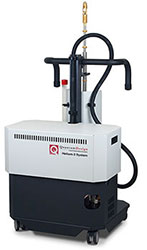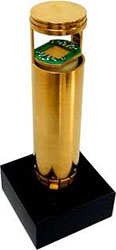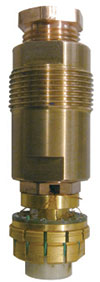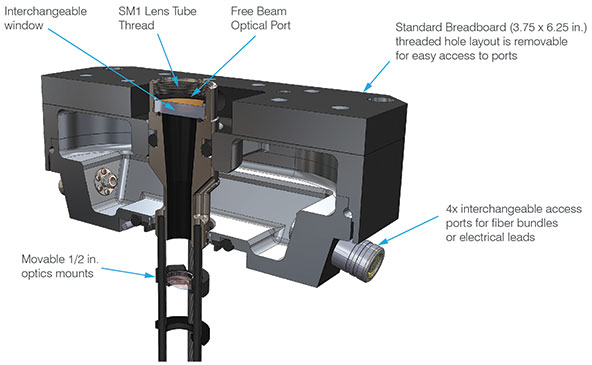get a quote
The PPMS DynaCool also comes standard with an integrated Cryopump used to pump out the sample space to a vacuum of < 10-4 Torr. This makes the PPMS DynaCool compatible with all the available options, or any other user-designed experiments, right out of the box!
Features:
• No need for liquid cryogens
• Temperature range of 1.8 K – 400 K
• 9 tesla and 14 tesla magnets available
• Continuous Low-Temperature Control – maintains temperatures below 4.2 K and offers smooth temperature transitions when warming and cooling through 4.2 K
• Controlled temperature Sweep Mode
• Fully automated operation of available PPMS applications/options
• Built-in Cryopump for high vacuum applications
• New electronics built using CAN architecture for improved reliability
• Standby mode conserves power while requiring only a short recovery time
Applications
Integrated DynaCool Measurement Applications
PPMS Family Options Compatibility Table
Video Dynacool link - https://www.youtube.com/watch?v=kktF6BhcnU0
PPMS® DynaCool™
Quantum Design
The popular Physical Property Measurement System (PPMS) from Quantum Design is now available in a truly cryogen-free package. The PPMS DynaCool, Quantum Design’s latest development effort, uses a single two-stage Pulse Tube cooler to cool both the superconducting magnet and the temperature control system, providing a low vibration environment for sample measurements. Utilizing a new approach to cryocooler equipment design, the PPMS DynaCool employs a unique 4He-based gas flow control system that gives you the rapid temperature cycling and accurate temperature control that you have come to expect from a PPMS.The PPMS DynaCool also comes standard with an integrated Cryopump used to pump out the sample space to a vacuum of < 10-4 Torr. This makes the PPMS DynaCool compatible with all the available options, or any other user-designed experiments, right out of the box!
Features:
• No need for liquid cryogens
• Temperature range of 1.8 K – 400 K
• 9 tesla and 14 tesla magnets available
• Continuous Low-Temperature Control – maintains temperatures below 4.2 K and offers smooth temperature transitions when warming and cooling through 4.2 K
• Controlled temperature Sweep Mode
• Fully automated operation of available PPMS applications/options
• Built-in Cryopump for high vacuum applications
• New electronics built using CAN architecture for improved reliability
• Standby mode conserves power while requiring only a short recovery time
Applications
Integrated DynaCool Measurement Applications
PPMS Family Options Compatibility Table
Video Dynacool link - https://www.youtube.com/watch?v=kktF6BhcnU0
Temperature Stages
Low Temperature Stages Measurement Options:Helium-3 Refrigerator
• Continuous operation down to 0.5 K
• Compatible with Heat Capacity, Electrical Transport and DC Resistivity measurements

Dilution Refrigerator
• Continuous operation from 4 K down to 50 mK
• Compatible with Heat Capacity, AC Susceptibility for DR, and Electrical Transport measurements
Adiabatic Demagnetization Refrigerator (ADR)

• World’s fastest <100 mK cryogenic refrigerator for PPMS & DynaCool
• From 300 K to <100 mK in <3 hours
• Holds temperature below 1.9 K for more than 2 hours
• Allows DC resistivity and Electrical Transport measurements
• 8 leads allow for measurements of two samples simultaneously
• Sample space: 23 mm diameter and 14 mm height
• Allows ultra-low temperature measurements with lower financial investment
• Measurements only in zero field
• PPMS Requirements: High vacuum and DC resistivity
Thermal Measurement
Thermal Measurement OptionsHeat Capacity
• Completely automated relaxation technique from 1.8 - 400 K
• Integrated data acquisition electronics and analysis software
Thermal Transport
AC Resistivity ρ
• Measured by using precision DSP current source and phase-sensitive voltage detection.
Thermal Conductivity κ
• Measured by applying heat from the heater shoe in order to create a user-specified temperature differential between the two thermometer shoes.
Seebeck Coefficient α
• Measured by creating a specified temperature drop between the two thermometer shoes - just as it does to measure thermal conductivity. However, for Seebeck coefficient the voltage drop created between the thermometer shoes is also monitored.
Thermoelectric Figure of Merit ZT
• Determined here simply as the algebraic combination α2T /(κρ) of the three measured quantities - thermal conductivity, Seebeck coefficient, and AC electrical resistivity.
Magnetometry
Magnetometry Measurement OptionsVibrating Sample Magnetometer (VSM)
• RMS Sensitivity: < 10-6 emu with 1 sec averaging
• Optional VSM Oven up to 1000 K
Torque Magnetometry
• Measures the magnetic torque = mBsinθ
• Designed to measure moments of very small anisotropic samples
• Moment Sensitivity: 1 x 10-7 emu at 9T; 1 x 10-8 emu at 14T
AC Susceptibility (ACMS II)
• AC Susceptibility
• Sensitivity: 1 x 10-8 emu
• Amplitude: 0.005 Oe – 15 Oe (peak)
• Frequency Range: 10 Hz – 10 KHz
• Direct phase nulling technique measures and cancels background AC phase shifts at every measurement
• DC Magnetization
• Sensitivity: 5 x 10-6 emu
AC Susceptibility for DR (ACDR)
• AC Susceptibility
• Drive Amplitude: 0.002 Oe – 4 Oe (peak)
• Sensitivity: 5x10-7 emu
• Phase Accuracy: 2°
• Frequency Range: 10 Hz to 10 kHz
• DC Field Range
• Up to ±12T
• Temperature Range
• 50mK – 4K

Magneto-Optic
Sample Rods:
• Choice of UV or IR Rod
• UV >90% transmittance 325 nm - 900 nm
• IR >90% transmittance 375 nm - 2250 nm
• Sample holder volume 2.68 mm3
• Moment Sensitivity
Electro-Transport
Electric-Transport Measurement OptionsDC Resistivity
• Four independent channels for performing DC resistivity
• Temperature Range: Down to 500 mK with He3 Option
• Current Range: 2 nA to 8 mA
• Sample Resistance Range: Up to 5 MOhm
Electrical Transport (ETO)
• For performing AC Resistance, Hall Effect, I-V, and Differential Resistance (dV/dI vs. I) measurements.
• 1nV sensitivity, 10 nΩ resolution at 100 mA
• AC and DC drive amplitude 10 nA to 100 mA
• Resistance ranges from 10 µΩ to 5 GΩ
Horizontal Sample Rotator
• Thermometer located on rotator platform
• Precision, stepper controlled rotator
• Step Size: 0.013 degrees (standard); 0.0011 degrees (high resolution)
• Angle Range: -10 degrees to 370 degrees
Multi-Function Probe
• Direct axial ports to the sample stage are provided to install light pipes, fiber optic cables, microwave guides and/or extra electrical leads
High Pressure
High Pressure Cell for MagnetometryIntroducing a novel, high pressure cell for magnetometry that allows easier sample insertion and removal without the need of an hydraulic press. This pressure cell, manufactured by HMD, comes in a complete kit that contains all the accessories you will need to aid in the characterization of your samples.


Benefits of the HMD Pressure Cell:
• All BeCu design for more uniform magnetic background
• No copper ring seal ensures easy sample removal
• All necessary accessories conveniently packaged
• Compatible with VSM transport
• No hydraulic press necessary
Specifications:
• Maximum Applied Pressure – 1.3 GPa
• Sample Space Diameter – 1.7 or 2.2 mm
• Sample Space Length – 7 mm max
• Cell Diameter – 8.5 mm
• Temperature Range – 1.8 to 400K
** Please Note: Requires VSM and Large Bore Coil Set **
Hydrostatic Pressure Cell for Electrical Measurements
Introducing a hydrostatic pressure cell for electrical measurements designed for use in all PPMS platform instruments (PPMS, DynaCool, VersaLab) . This pressure cell, manufactured by ElectroLab, is compatible with Quantum Design’s DC Resistivity, ACT and ETO measurement options.

Benefits of the ElectroLab Pressure Cell:
• Based on BeCu pressure cell technology
• Integrated external thermometer
• 10 sample leads (5 twisted pairs)
• Compatible with all QD PPMS platforms
• Manufactured by the leading supplier of hydrostatic pressure cells in Japan
• Several press sets also available
Specifications:
• Maximum Applied Load – 3.0 GPa
• Maximum Sample Pressure – 2.7 GPa
• Sample Space Diameter – 4.0 mm
• Sample Space Length – 6.0 mm max
• Temperature Range – 1.9 to 400K
Spectroscopy
Spectroscopy Measurement OptionsRaman & Luminescence Spectroscopy System

Quantum Design's new Spectroscopy System combines Raman and Photo-Luminescence spectroscopy with optical sample imaging in the variable temperature and magnetic field environment of the PPMS. Using this "turn-key" system, gaseous, liquid and solid materials, in bulk or thin film form, may be investigated. Raman spectroscopy is a non-destructive spectroscopic technique used to identify and explore vibrational, rotational, and other excitation modes in a sample. Raman spectroscopy is commonly used to identify crystalline materials by measuring their specific Raman "fingerprint." This is done by measuring the inelastic scattering of light. In crystalline samples, the inelastic gain or loss of energy produces narrow discrete peaks known as Stokes and Anti-Stokes peaks, respectively. Glasses, in contrast, have broad vibrational spectra that in turn give rise to broad Raman spectra. When using the versatile PPMS Spectroscopy System, the study of spin-lattice coupling in strongly correlated oxides as a function of temperature and magnetic field is made easy through the highly automated MultiVu interface.
• Various Wavelengths (532, 785, and 850 nm)
• Tilt and Tip control
• Volume Holographic Grating
• Ultra-Narrow-Band Notch Filter
• Compact Footprint
Applications
• Structural Identification
• Impurity Detection
• Crystallization Analysis
• Bulk and thin film
• Stokes and Anti-Stokes Signal
NanOsc FMR Spectrometers

The CryoFMR spectrometer is a plug and play system that allows broadband CPW-FMR characterization with lock-in capability. It includes its own RF frequency source as well as lock-in detection module, so that the only parts required to conduct an experiment are a computer for software control and a PPMS platform. Temperature range: 4 K to 400 K. Frequency Range 2 to 17 GHz.
Compact Imaging Spectrograph
(Andor Shamrock 193i Spectrograph with iVac 316 CCD)

Quantum Design now adds in-situ structural and chemical spectra analysis to PPMS materials characterization measurements at low temperature and high magnetic fields. This ability answers a growing demand in the research community. Offering a wide range of modular interfaces that feature cage system couplers, Quantum Design offers endlessly configurable connections between the Compact Imaging Spectrograph and the PPMS Optical Multi-Function Probe (OMFP). The spectrograph's "wide aperture" slit opens the door to a single set up with the OMFP to image the sample, while also allowing spectral information collection through the same optical path from the microscope.
Features
• Integrated control and data acquisition through PPMS MultiVu software
• Dual grating turret with RFID
• Dual Detector Output
• Adaptive Focus
• Pre-aligned and calibrated
• Compact and rugged design
Applications
• Absorption, Transmission, and Reflection
• Raman (532, 785, and 850 nm)
• Fluorescence and Luminescence
Expansion
Expansion Measurement OptionsDilatometer

Measures relative expansion (dilation) and first derivative (coefficient of expansion) with respect to temperature and field, with sub-angstrom sensitivity. This is accomplished using a differential ratiometric capacitance bridge, operating at 2.340 kHz, which offers high sensitivity and dynamic range.
Optics
OpticsOptical Multi-Function Probe (OMFP)
The newly designed Optical Multi-Function Probe (OMFP) offers unprecedented flexibility and versatility that allows you to conduct photonic, quantum optics and correlative microscopy experiments within the variable temperature and magnetic field environments of the PPMS, DynaCool and VersaLab. The OMFP probe features a room temperature “head” with multiple access ports and integrated optical breadboard for mounting optical components such as spherical and achromatic lenses, turning mirrors, filters, diffusers, beam splitters, prisms, waveplates, fiber bundles and electrical wiring. The open modular design of the probe head provides easy access to the axial ports and connectors which can be configured to route electrical, single fibers, fiber bundles and miniature waveguides to the sample space. In addition, a central optical access port allows free-beam optics experiments in the cryostat. A 0.5 in. standard optical thread mount makes aligning and focusing lens assemblies fast and easy.

Features
• Available for VersaLab, DynaCool and PPMS
• Half inch (SM05) free-beam access port for optical capability along optical path
• Direct axial electrical, SMA and other ports to sample stage provided to install light pipes, fiber optics cables, and/or electrical leads
• 2 sets of 4 electrical leads on sample PCB interface for electrical transport experiments
• Multiple measurement capability (e.g., electrical resistivity, Hall effect, Van der Pauw, magnetometry and other optical measurements)
• Integrated wiring for optional motorized Cartesian positioning system (3 x 3 x 3 mm movement capability)
• Sample stage with integrated thermometer
• Multi-Position filter and lens mounts for cold region of probe
• 300 K to 50 K, ± 3 T (VersaLab); 300 K to 1.8 K, ± 14 T (DynaCool); 300 K to 1.9 K, ± 16 T (PPMS)
Applications
• Free optics studies
• Fiber optics measurements
• Thermal-Optical properties
• Magneto-Optical properties
Cartesian Positioning System

A fully motorized Cartesian sample positioning system can be used with our Optical Multi-Function Probe (OMFP) to focus a laser beam or other excitation source on a particular region of the sample. The Cartesian positioning system provides for an XYZ movement capability of 3 x 3 x 3 mm.
Xenon Light Source

• Choice of 150 W or 300 W light source
• Xenon Arc Lamp
• 10 position filter wheel
• 9 bandpass filters (436 nm, 470 nm, 500 nm, 530 nm, 555 nm, 585 nm, 640 nm, 740 nm, 850 nm)
PDFs
- PPMS Dynacool System
- PPMS Platform Measurement Options (Full Brochure)
- PPMS Options Compatibility Table.pdf
- AC Resistance (ETO)
- DC Resistance
- Van der Pauw - Hall Transport
- Horizontal Rotator
- Pressure Cell (Transport)
- Vibrating Sample Magnetometer (VSM)
- Large Bore Coil Set (VSM)
- VSM Oven
- AC Susceptibilty (ACMS II)
- First Order Reversal Curve (FORC) Software for VSM
- Fiber Optic Sample Holder (FOSH) for VSM
- Pressure Cell (Magnetometry)
- Torque Magnetometry
- Heat Capacity
- Thermal Transport Option (TTO)
- Dilatometer
- Dilution Refrigerator
- Helium-3 Refrigerator
- Adiabatic Demagnetization Refrigerator (ADR)
- AC Resistance, DC Resistance, Heat Capacity for ADR, Helium-3, DR
- AC Susceptibilty Option for the Dilution Refrigerator (ACDR)
- Multi-Function Probes
- Optical Multi-Function Probe (OMFP)
- Raman Spectroscopy System
- NanOsc FMR Spectrometers
- Light Sources
- Optix Breadboard
Papers








